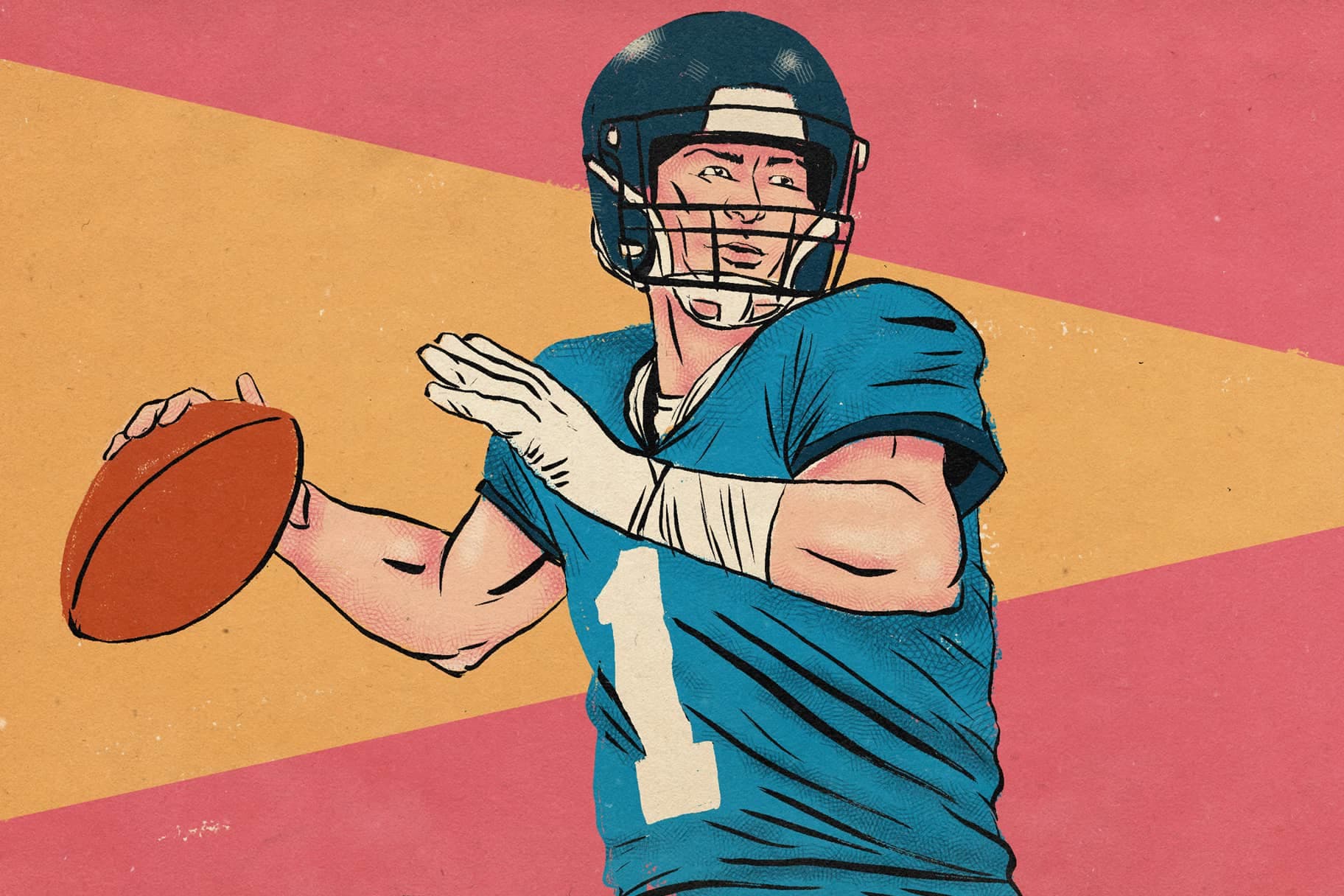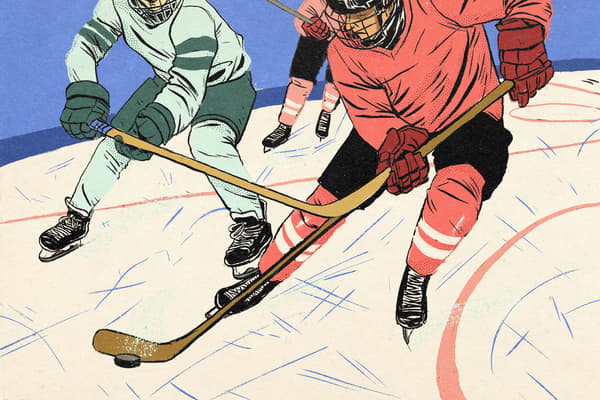Introduction to American Football: How to Play the Game
Sport & Activity
In this beginner's guide to American football, learn the fundamentals of the game—from first downs to extra points.

American football can be an exciting sport to watch and play—but it can also be confusing if you're unfamiliar with it. To understand the game of American football, read on for a breakdown of the objective, scoring, timekeeping, positions and order of play.
Scoring in American Football

The goal of American football? It's pretty simple: to outscore the opposing team. Players score points in American football by getting the ball across the goal line into the end zone, either by throwing and catching the ball, running it in or kicking it through the field goal posts for a field goal.
A standard American football field is 120 yards long (109.7 metres approx.), rectangular in shape and can be made from grass or turf. The field of play is a little more than 50 yards wide (45.7 metres approx.) and exactly 100 yards long (91.4 metres approx.), with two 10-yard (9.1 metres approx.) end zones on either end. These end zones are the scoring areas on the field—each team attempts to score by carrying the ball into the end zone (either by running or catching).
Just beyond each end zone are field goal posts, through which the team can kick field goals (more on this below). The goal line is the line on the field that separates the end zone from the field of play.
"When the football crosses the goal line, by a throw or run, that is worth six points and is known as a touchdown", said Colton Korn, director of player personnel at Liberty University, a Division I National Collegiate Athletics Association (NCAA) programme in Lynchburg, Virginia. For context, Division I is the top level of intercollegiate sport, as defined by the NCAA.
"Following [a touchdown], you can kick an extra point, worth one point, or you can go for a two-point conversion, where you basically have to score a touchdown again but from the 3-yard line (2.7 metres approx.)", Korn said.
Note: In the National American Football League, two-point conversions are taken from the 2-yard line (1.8 metres approx.) and extra points are kicked from the 15-yard line (13.7 metres approx.).
If a team is unable to score a touchdown in four downs (more on that below), on the fourth down, they can kick a field goal through the goal posts, which is worth three points. "Any kick must go through the uprights to count for points", Korn said.
Another way a team can score points (while on defence) is by tackling a player of the opposing team in their end zone. If the offence (attack) is in possession of the ball and gets tackled in their own end zone, this is known as a safety and it's worth two points for the team on defence.
Order of Play

Football begins with a kick-off, with special teams lines from both teams on the field. The team that kicks the ball off will be playing defence, while the receiving team plays offence. The receiving team catches the ball at kick-off and tries to run it down the field as far as they can before being stopped (either tackled or run out of bounds) by the kicking team. After the kick-off play, the respective offensive and defensive lines come onto the field for both teams.
Note: The receiving team may also get a touchback, which is when they catch the ball in the end zone and take a knee, or when the ball is kicked beyond the end zone. When this happens, the offence automatically starts their drive down the field at the 25-yard line (22.9 metres approx.).
"The offensive team has four chances or plays, known as 'downs', to gain 10 yards (9.1 metres approx.)", Korn said. "As soon as 10 yards are gained, even if it's on second down, it resets the downs so the offence again has four chances to gain another 10 yards".
At the beginning of each play, the teams line up on opposite sides of the line of scrimmage, the imaginary line that separates the offence from the defence. The play starts when the centre snaps the ball to the quarterback. The quarterback can then hand off the ball for a running play to gain yards or throw it to a teammate to catch it and run downfield to the end zone.
The goal of the defence is to stop the offence from getting 10 yards in four downs by tackling ball carriers, breaking up passes or intercepting passes. The defence can also cause the offence to "fumble" or drop the ball and then the defence can pick up the ball themselves and play an offensive role by running it towards their end zone for a change in possession and—if they're lucky—a touchdown.
"If the defence succeeds and the offence is unable to get the 10 yards, the offence can punt the ball away on fourth down to the other team or they can decide to go for it and try to get the remaining yardage in a passing or running play", Korn said. "However, if the offence goes for the remaining yardage on fourth down and doesn't get it, the other team will start with the ball where it is".
Another option on fourth down is for the offence to try to kick a field goal if they're close enough to the end zone for three points (versus the six they would score for a touchdown). The ball changes possession after the offensive team:
- Attempts a field goal
- Fails to convert (aka earn a first down or score) on the fourth down
- Scores a touchdown (and attempts the extra point or two-point conversion)
The winner of the game is the team with more points when time runs out.
If the score is tied at the end of the fourth quarter, overtime will typically begin. The specific rules of overtime vary at different levels of play and in different leagues.
Timekeeping Basics

Football games have four quarters of play, each consisting of 15 minutes. However, games typically last about three hours, with frequent stoppages in time due to timeouts, breaks between quarters, pauses in between possessions and more.
The clock starts after the snap and stops after a number of different scenarios, including:
- When an incomplete pass is thrown
- After points are scored
- If a player who has possession of the ball steps out of bounds in the last two minutes of the first half or five minutes of the second half
- Timeouts (note: each team is allotted three timeouts per half)
- Penalties
- Injury
Players
Every American football team has a defensive line and an offensive line and players tend to strictly belong to one. There's also a special teams line, which goes out on the field for changes of possession. Within special teams, there are kick-off and kick-off return teams, punt and punt return teams, as well as a field goal unit. Every line consists of 11 players, so 11 players from each team are on the field at a time.
(Related: A Beginner's Guide to American Football Positions)
Offensive Positions

Players on offence are expected to score points by gaining yards with runs, throws, catches and passes. They also block players from the opposing team so the quarterback has time to make plays.
- Offensive line: This line comprises left tackle, left guard, centre, right guard and right tackle. The players on the offensive line start on the line of scrimmage at the beginning of every play. They "pass block" the defence so the quarterback has time to throw the ball or "run block" so the running back or fullback can run the ball for yardage. The centre snaps the ball to the quarterback to start a play.
- Quarterback: This player—known as "QB"—runs the offence. At the start of each play, the centre snaps the ball to the quarterback, who either tries to pass, hand off or run the ball to get yards down the field.
- Running back: This player takes handoffs from the quarterback to run for yardage but can also make catch plays and block.
- Fullback: The fullback is the lead blocker. This player can run and block for the quarterback and running back, so that these players can make plays without being tackled.
- Wide receiver: Wide receivers are known for catching passes. Occasionally, wide receivers take handoffs and block players. They also tend to be some of the quickest runners on the field.
- Tight end: A tight end acts as a mix between a receiver and offensive lineman. This player blocks for the quarterback and running back and can also receive passes.
Defensive Positions

The main goal of those playing defence is to stop the opposing team's offence from scoring or gaining 10 yards in four downs. The defence does this by tackling ball carriers, tackling players who catch the ball, intercepting passes and causing fumbles. While not their primary role, the players also have the ability to score touchdowns if they make an interception or recover a fumble.
- Defensive line: Lining up on the line of scrimmage opposite the other team's offensive line, the defensive line consists of three to four players, including two defensive ends and one or two defensive tackles. The defensive line is the first line of defence against the other team's offence and its top priority is to tackle offensive players and stop them from gaining yards.
- Linebacker: There are always three or four linebackers on the field, including outside, inside and middle linebackers. These players cover running backs, tight ends and wide receivers; rush the offensive passer; and tackle ball carriers.
- Cornerback: There are two to four of these players on the field. They're typically the fastest players on defence and generally cover wide receivers. They also aim to break up and intercept passes as well as tackle players who catch passes.
- Safety: These comprise two positions on the field: strong safety and free safety. They are the last line of defence, playing downfield but also running support. They defend deep passes and tackle ball carriers.
Special Teams

These players perform kickoffs, punts and field goals.
- Kicker: This player kicks the ball for kickoffs and field goals.
- Punter: Punters are responsible for punting, aka kicking the ball downfield for the other team to recover, if the offence fails to convert a first down.
- Kick returner: This person receives the ball from the kicker after kick-off and tries to run downfield to gain yardage.
- Punt returner: Similar to the kick returner, this player receives the ball from the punter and tries to run downfield to gain yardage.
- Long snapper: This player "snaps" the ball—a longer distance than the centre does on a normal play—to the kicker or punter.
Words by Amy Schlinger




